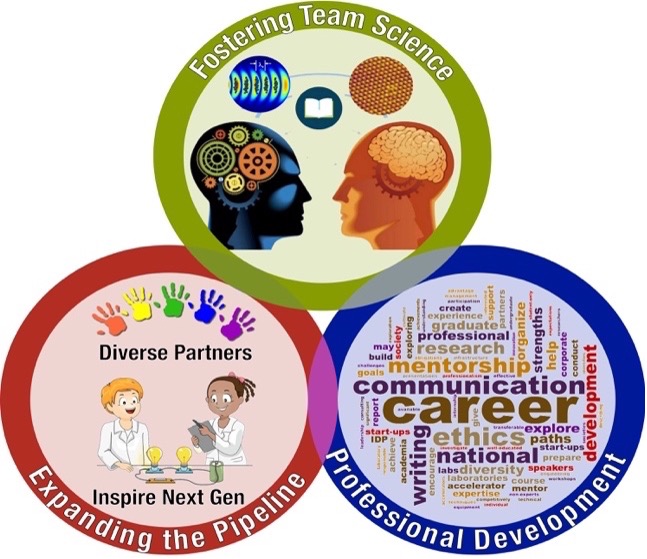Culture and Inclusion
The Center for Bright Beams – A Culture of Inclusion
Scientific progress at the Center for Bright Beams relies on teamwork, which thrives because of a highly inclusive environment. Another outcome of this culture of inclusion is that CBB has become a diverse community that is having a measurable impact on the participation of underrepresented groups in sciences and technology, particularly in accelerator science.
Resources for Increasing Diversity in Science:

Creating a Culture of Teamwork:
- Team-Based Science – Strategies for Success, Practical Tools, and Future Directions, Dr. Kara Hall.
- Team Science: Current State of Knowledge with Dr. Kara Hall.
- CBB Handbook
- Collaboration and Team Science - From Theory To Practice
- Collaboration and Team Science: A Field Guide
- The Science of Team Science Webinar
- Team Science Workshop "Crash Course"

Effective Mentoring:
Mentoring creates a culture of inclusion through the sharing of knowledge and experience, creating a level playing field for all.
- National Mentoring Community: Supporting diversity in undergraduate physics
- National Research Mentoring Network
- MyMentor: Build your virtual mentoring network
- Pathways to Science Mentoring Manual
- Mentor Resource Library from APS
- National Academies of Science videos and guide on effective mentorship STEMM online guide

Understanding Implicit Bias:
Implicit bias is an automatic reaction we have towards other people. These attitudes and stereotypes can negatively impact our understanding, actions, and decision-making.
- Project Implicit: The Implicit Association Test (IAT) measures attitudes and beliefs that people may be unwilling or unable to report. For example, you may believe that women and men should be equally associated with science, but your automatic associations could show that you associate men with science more than you associate women with science. Awareness of our biases is the first step in combatting them.
- Diversity in Science – An Everyone Issue with Dr. Corrie Moreau.
- Fair Play a NIH-funded game that provides players with the opportunity to take the perspective of a black graduate student. Players experience racial bias during interactions with other characters.

Increasing Diversity in Physics:
- The Center for Bright Beams is a member of the Institute for Broadening Participation (IBP) and participate in their PathwaysToScience program.
- Diversity Toolbox for students and faculty
- Student Resources: Search 1,000+ fully funded STEM programs and funding opportunities nationwide
- TeamUP: The AIP National Task Force to Elevate African American Representation in Undergraduate Physics & Astronomy (TEAM-UP)
- TEAM-UP Full Report
- TEAM-UP recommendations
- STEP UP is a national community of physics teachers, researchers, and professional societies. We design high school physics lessons to empower teachers, create cultural change, and inspire young women to pursue physics in college.
- Minorities in Physics Resource from APS
